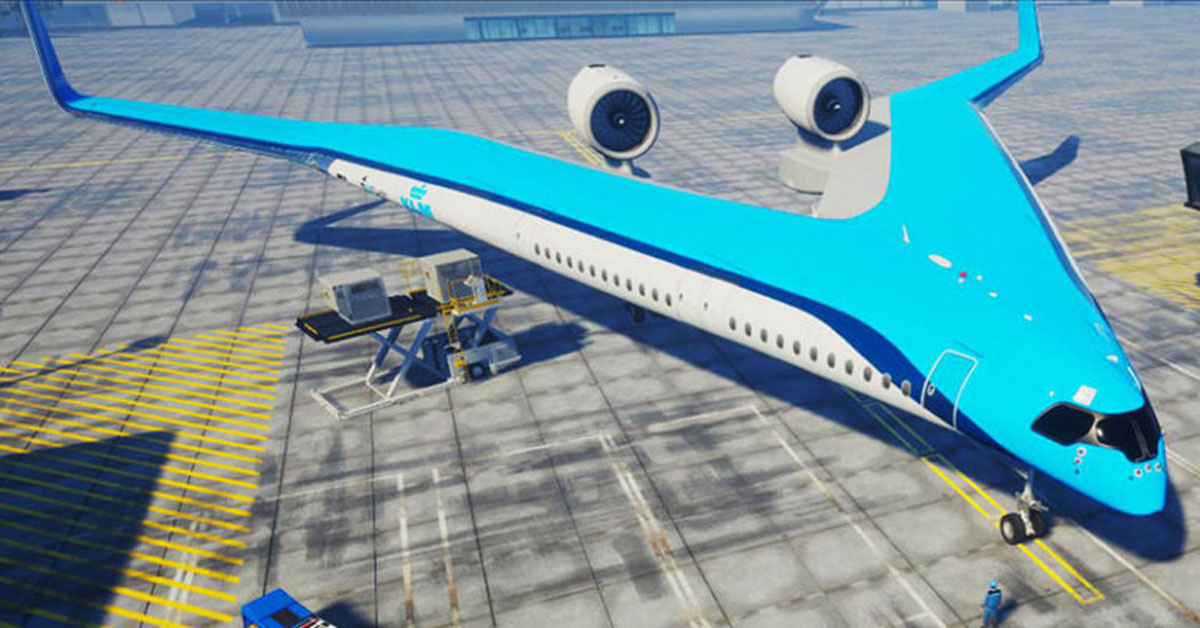After decades of aircraft design staying the same, the future of flying might just be here. Meet the new flying-v prototype from Royal Dutch Airlines.
The Flying-V From KLM
A scaled model of Royal Dutch Airline’s (KLM) new airplane design has undergone its first-ever test flight. Called the Flying-V after it’s v-shaped design, this may be the future of flying as we know it. (1)
Rather than the traditional design of a single tubular body with wings on either side, this design, developed and tested by engineers at the Delft University of Technology (TU Delft), the fuselage and wings are one and the same. Passengers would be seated literally inside each wing. Turbofan engines sit on top of the fuselage between the two “wings” rather than under the wings like on traditional aircraft. (1)
The idea is to have a plane design that is more aerodynamic and therefore more fuel-efficient. It can go further on less fuel and is better for the environment as a result. (1)
The First Flight
KLM and TU Delft engineers went over to Germany for the first test flight of the scaled-down model of the Flying-V. The flight was controlled by a drone pilot using a remote control.
The purpose of using a smaller, scaled version is to ensure that the aircraft does, indeed, fly before spending money, time, and resources on building a full-size prototype. (1)
Other than a bumpy landing that caused some damage to the plane’s nose, the flight was a success. KLM attributed this to an unexpected gust of wind and the drone pilot’s ability to react to that gust, which is common with scaled test flights. According to the company, one out of two scaled models is damaged this way during test flights. (2)
“It’s been two years of intense stressful work to reach this moment,” Malcolm Brown, TU Delft’s chief engineer for the Flying-V testing program, said in the YouTube video KLM put out about the flight. “And then to have it confirmed that it flies, all of that hard work, it was worth putting in all of the hours making sure everything’s correct and built properly, built accurately, and it pays off.” (1)
A More Fuel-Efficient Future
Finding a way to make airplanes more fuel-efficient and air travel less damaging to the environment are top priorities for those in the industry. According to researchers, the flying-wing design can lower fuel consumption by 20% from even the most advanced planes that we have today. (1)
KLM says that the flying-v will have the same wingspan as the Airbus A350. This means that it would be able to use the same gates and runways as current planes. The plane will fly further and with more passengers on less fuel. (1)
The flying-v scaled prototype will go through a couple more test flights before KLM and TU Delft begin working on a full-size model. The design and building of this will be an investment in the billions, and while KLM has not yet said when we can expect to see these planes on the runway, normally the process from drawing the design to having the plane certified for commercial flight takes about a decade. (1)
Other Flying-V Models
The United States military has its own version of the flying-wing design called the B-2 Spirit. It is a stealth bomber that has been in use since 1993. The B-2 Spirit can fly up to 6,000 nautical miles non-stop and is designed both for speed and stealth. (1)
Though it will be quite sometime before you and your family will be boarding a flying-v for your test destination vacation, the future of aircraft is certainly going to be an innovative one.
Read More: World’s First Airport For Flying Cars And Drones To Open This Year
Sources:
- ‘A prototype of KLM Royal Dutch Airlines’ futuristic-looking flying-wing aircraft just took its first flight in Germany — take a look at the Flying-V’ Business Insider Thomas Pallini. Published September 7, 2020.
- ‘New Flying-V Plane Prototype Takes To The Skies For The Very First Time’ Unilad Emily Brown. Published September 8, 2020.

